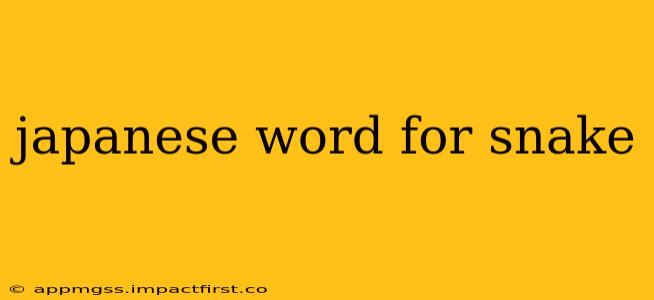The Japanese language, rich in its vocabulary, offers several ways to say "snake," each with subtle differences in connotation and usage. This exploration delves into the most common terms, their meanings, and when to use them. Understanding these nuances will help you communicate more accurately and naturally in Japanese.
What is the most common Japanese word for snake?
The most common and widely understood word for snake in Japanese is 蛇 (へび - hebi). This is the word you'll encounter most frequently in dictionaries, textbooks, and everyday conversation. It's a general term and doesn't carry any specific positive or negative connotations.
Are there other words for snake in Japanese?
Yes, while へび (hebi) is the most common, other words exist, each with its own specific usage:
大蛇 (おおへび - ōhebi):
This term translates to "big snake" or "giant snake." It's used specifically to describe snakes of considerable size, often referencing mythical or legendary creatures. The prefix "ō" (大) signifies largeness or greatness.
蝮 (まむし - mamushi):
Mamushi refers to the Japanese mamushi viper, a venomous snake species native to Japan. This word is specific to this particular type of snake and carries a sense of danger and toxicity. Using it when referring to other snake species would be inaccurate.
ヘビ (hebi) - Katakana vs. Kanji
While both are pronounced the same, using the Katakana spelling (ヘビ) versus the Kanji (蛇) can subtly alter the feel. Kanji often conveys a more formal or traditional tone, while Katakana is slightly more modern and casual. The context usually dictates which writing system is best suited.
What are some common phrases related to snakes in Japanese?
Beyond single words, several phrases incorporate the word "snake" to convey different ideas:
- 蛇に睨まれた蛙 (へびににらまれたかわず - hebi ni niramereta kawazu): This idiom translates to "a frog glared at by a snake." It describes someone paralyzed by fear or intimidation.
- 蛇の目 (へびのめ - hebi no me): This literally means "snake's eye," and it's often used to describe patterns resembling snake eyes, particularly in fabrics or designs.
How do you say "snake" in Japanese slang?
There isn't a widely used slang term specifically for "snake" in Japanese. The standard word へび (hebi) suffices in most casual contexts. However, the context and tone of the conversation might influence how it’s used or what descriptive words accompany it.
What is the difference between the words for snake in Japanese?
The primary difference lies in specificity. へび (hebi) is a general term. Ōhebi (大蛇) specifies size, while mamushi (蝮) denotes a particular venomous species. The choice depends on the context and the type of snake being discussed.
This comprehensive overview should equip you with a deeper understanding of the various Japanese words for "snake" and how to use them appropriately. Remember, contextual understanding is key to effective communication in any language.
